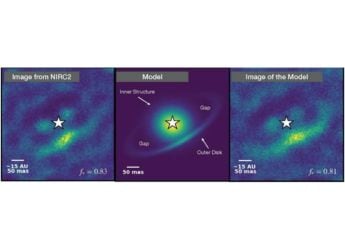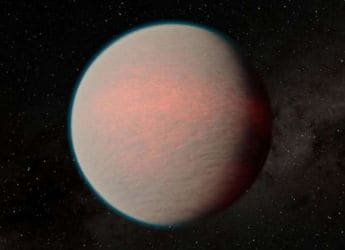- Home
- Science
- Science News
- NASA's James Webb Space Telescope Telescope Challenges Old Theories on Mini Neptune Worlds
NASA's James Webb Space Telescope Telescope Challenges Old Theories on Mini-Neptune Worlds
Astronomers once thought mini-Neptunes were covered by global magma oceans.

Photo Credit: NASA/JPL-Caltech/R. Hurt (IPAC)
Study finds many mini-Neptunes face immense pressure, making their surfaces likely solid
Many so-called mini-Neptunes, smaller than Neptune but with thick atmospheres of hydrogen-helium, have been found by astronomers. It is even possible that the closest type of planet in our galaxy is mini-Neptunes. It was believed that these worlds had been covered by magma oceans around the world. Nevertheless, it has been proposed by a new study that the crust would be pressed together by the heavy atmospheres in solid rock instead of molten lava. In fact, this discovery contradicts previous theories regarding these worlds.
Solid surfaces under pressure
According to the study, scientists had assumed that searing heat and thick gas layers would melt mini-Neptune crusts into global magma oceans. However, data from NASA's James Webb Space Telescope suggested a mini-Neptune's atmosphere contained heavier molecules than expected, implying an extremely thick, high-pressure blanket.
Models showed that this crushing pressure would force molten rock to solidify (much like carbon turning into diamond under pressure). Extending these calculations, the team found that many mini-Neptunes once assumed to be “lava worlds” likely have solid floors.
Implications for planet formation
Since mini-Neptunes are one of the most abundant planets in the galaxy, the fact that many of them contain solid surfaces makes scientists reconsider the theory of planet formation. In the past, other solar systems were predicted to be similar to the one, which cannot be the case with mini Neptuns.
It is also useful in clarifying the formation of planets by presenting a complete picture of whether the planets are molten or solid. In the end, this knowledge can inform the hunt for Earth-like worlds and help understand the history of the Earth itself.
Get your daily dose of tech news, reviews, and insights, in under 80 characters on Gadgets 360 Turbo. Connect with fellow tech lovers on our Forum. Follow us on X, Facebook, WhatsApp, Threads and Google News for instant updates. Catch all the action on our YouTube channel.
Related Stories
- Samsung Galaxy Unpacked 2025
- ChatGPT
- Redmi Note 14 Pro+
- iPhone 16
- Apple Vision Pro
- Oneplus 12
- OnePlus Nord CE 3 Lite 5G
- iPhone 13
- Xiaomi 14 Pro
- Oppo Find N3
- Tecno Spark Go (2023)
- Realme V30
- Best Phones Under 25000
- Samsung Galaxy S24 Series
- Cryptocurrency
- iQoo 12
- Samsung Galaxy S24 Ultra
- Giottus
- Samsung Galaxy Z Flip 5
- Apple 'Scary Fast'
- Housefull 5
- GoPro Hero 12 Black Review
- Invincible Season 2
- JioGlass
- HD Ready TV
- Laptop Under 50000
- Smartwatch Under 10000
- Latest Mobile Phones
- Compare Phones
- Huawei Mate 70 Air
- Moto G57
- Moto G57 Power
- Motorola Edge 70
- Moto G Play (2026)
- Moto G (2026)
- Realme C85 Pro 4G
- Realme C85 5G
- MacBook Pro 14-inch (M5, 2025)
- Asus Vivobook S16 (S3607QA)
- iQOO Pad 5e
- OPPO Pad 5
- Garmin Venu X1
- Redmi Watch 6
- Samsung 65 Inch LED Ultra HD (4K) Smart TV (UA65UE84AFULXL)
- Samsung 55 Inch QLED Ultra HD (4K) Smart TV (QA55QEF6AULXL)
- Asus ROG Ally
- Nintendo Switch Lite
- Haier 1.6 Ton 5 Star Inverter Split AC (HSU19G-MZAID5BN-INV)
- Haier 1.6 Ton 5 Star Inverter Split AC (HSU19G-MZAIM5BN-INV)

















